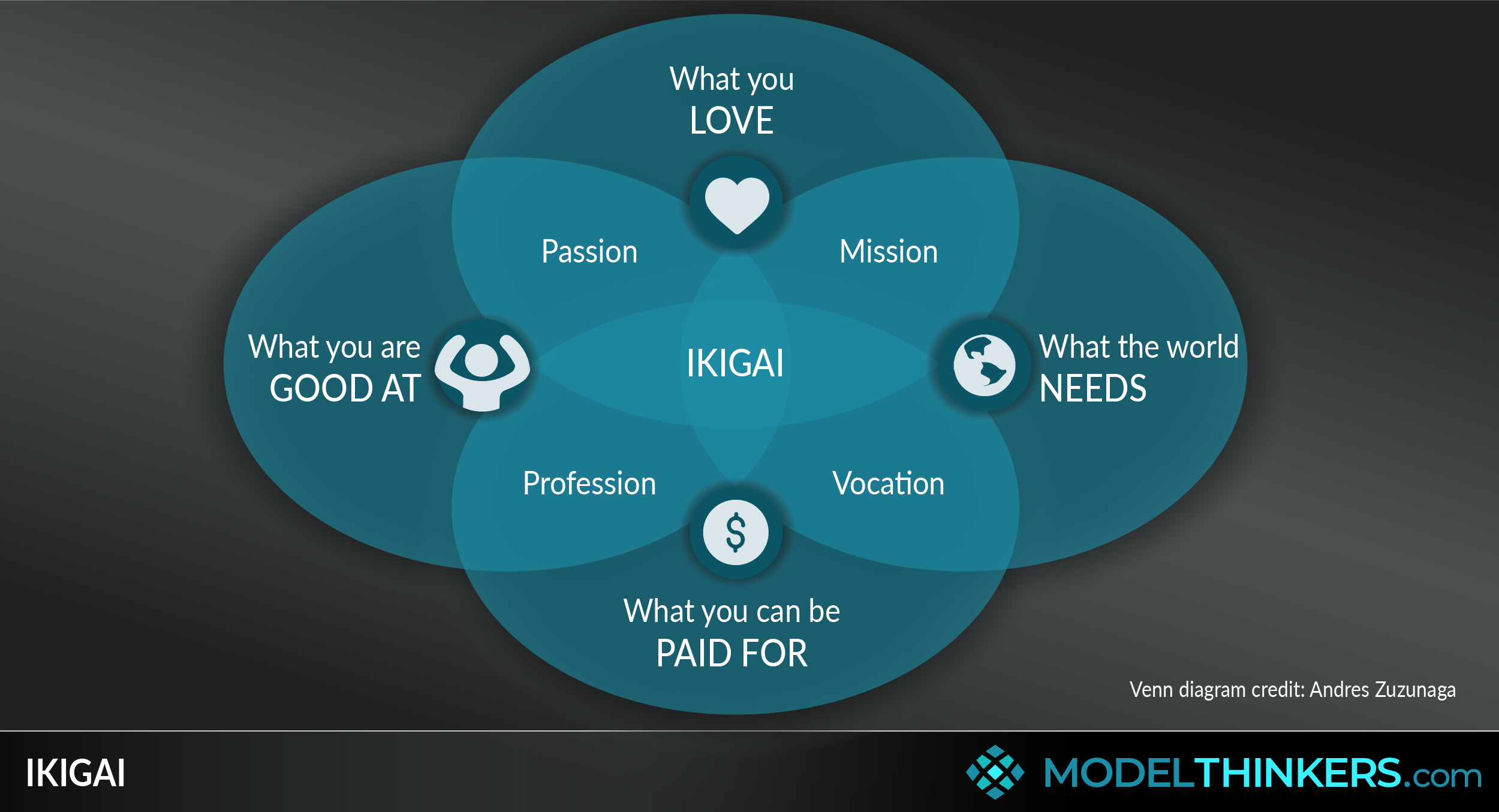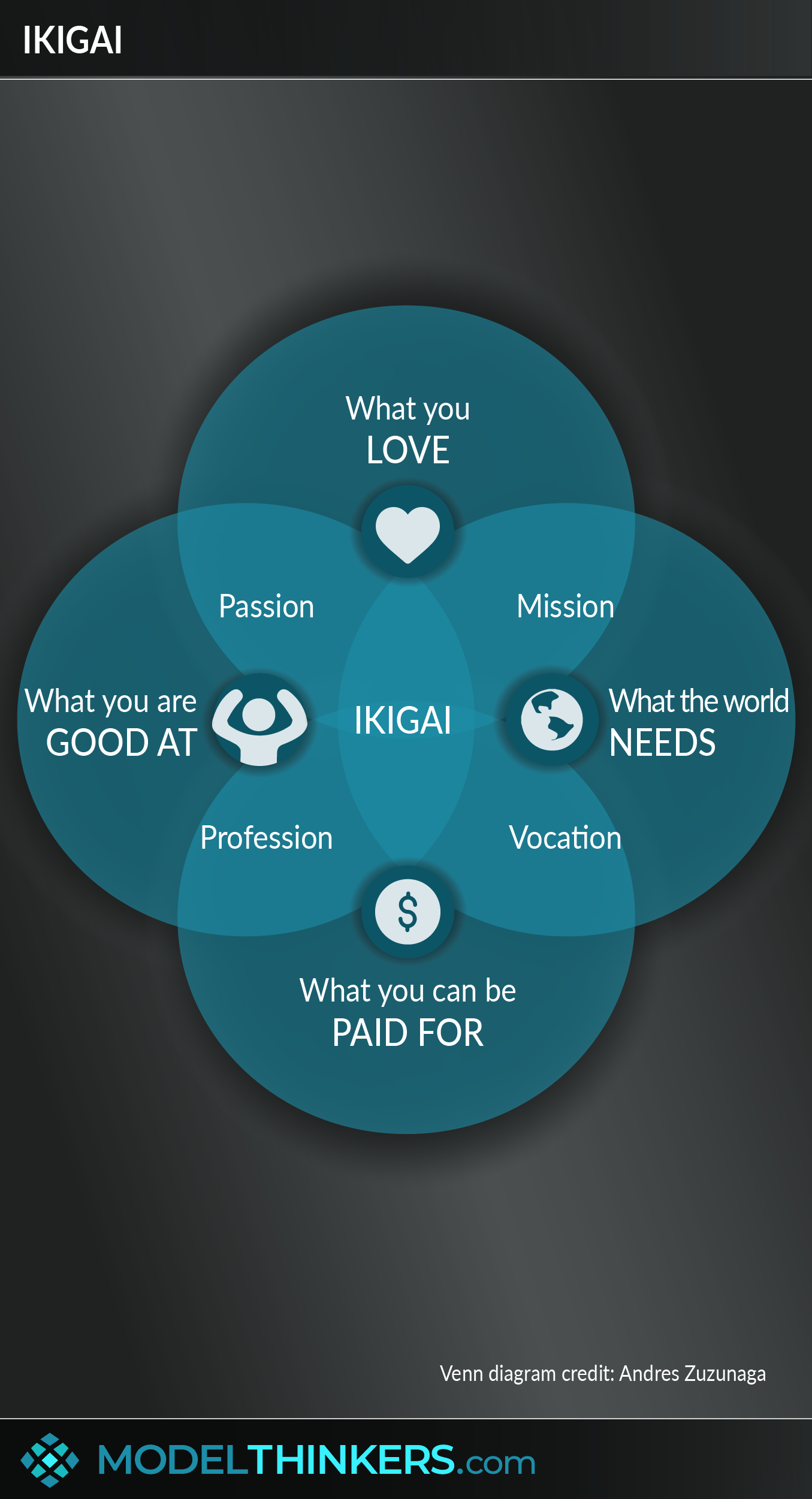

 0 saved
0 saved
 74.6K views
74.6K views








Why do you get out of bed in the morning and what fills your soul? Is your life on track and are you really feeling fulfilled? Sorry if we're triggering an existentialist crisis, but it's not a bad state to explore Ikigai.
Ikigai is a Japanese-inspired mental model that means ‘a reason for being’ of life value, and can be used to help find your motivation and purpose.
ORIGINALLY BEYOND ECONOMICS.
Noriyuki Nakanishi of Osaka University explained: "Ikigai gives individuals a sense of a life worth living. It is not necessarily related to economic status. Ikigai is personal; it reflects the inner self of an individual and expresses that faithfully. It establishes a unique mental world in which the individual can feel at ease."
THE WESTERN VERSION.
The more common and popularised western version of the model arose sometime later (see below in origins & resources), and presents four guiding questions, the intersection of which will identify your reason for being:
- What do you love?
- What are you good at?
- What does the world need?
- What can you be paid for?
Again, it could be argued that the latter two questions are not part of the original Japanese concept, but were popularised in the west with the incorporation of the venn diagram.
SEEKING HAPPINESS.
Whichever interpretation you work with, proponents argue that finding your Ikigai will bring you fulfilment, happiness and longer life - so pretty much everything that's worth anything. Some ways to apply this concept into your life include:
- Rating your current life choices against those four questions or segments, tracking whether you're leaning into what you love, what you're good at, what the world needs, and what you can be paid for.
- Scaling up or scaling down the approach to reflect in on your day versus your life direction.
- Know when to diversify your approach. It would be great if you had one approach that met all criteria, but if that's too challenging consider diversifying, this might involve accessing what you love through volunteering or a side hustle while spending some time earning money in other ways.
- Reminding yourself that everything changes, this approach is not set and forget. What you love, what you're good at, what the world needs and pays for are all dynamic areas subject to change, so keep reflecting and be open to changing your direction.
IN YOUR LATTICEWORK.
If you're not sure what your 'true passion' is, or you're having trouble identifying what you love, we highly recommend that you explore Jealousy as Map as an intuitive starting point. Self-coaching using the GROW Model might also support you to uncover your Ikigai and how you might better achieve it. Finally, be sure to explore Tal Ben-Shahar's Happiness Model for a related but different approach to being happier.




- Be aware of the four elements — passion, mission, vocation and profession.
Explore the convergence of ikigai’s four primary elements: what you love (your passion), what the world needs (your mission), what you are good at (your vocation), and what you can get paid for (your profession).
- Take time to reflect and design your life.
Many people are caught in cycles of being busy and reacting to events. Finding and maintaining Ikigai requires a level of ongoing reflection, considering the four questions as they relate to you in that moment. At the same time, it takes courage to consciously design an approach where your life and work sits in the intersection of those factors.
- Use ikigai as a daily guide rather than an end goal.
Rather than focusing on finding your ikigai as an end goal, use the model to find better balance in your life each day. For example, try rating your current situation or focus against the four elements and consider what might help you gain a more balanced result. Ask, what’s something that I can do today to start to address the imbalance.
- Stay compassionate and curious with the journey.
Your ikigai will not necessarily be fixed, nor will it necessarily be a single defined answer at any point of time. For many, it will involve experimentation and will develop over time. To achieve this requires a high level of compassion, patience and even playful curiosity to ensure that you don’t get frustrated and give up.
As an end goal, Ikigai sets high, perhaps even unrealistic expectations and can lead to more frustration and happiness as a result. Proponents argue that it’s best used as a loose guide, with considerable self-compassion, rather than a strict goal. In addition, claims about longer life related to this model are obviously difficult to verify.
We also hinted to another criticism in the overview section — the fact that there are two interpretations of the term. The original Japanese model versus the western interpretation as captured by the Venn-diagram. View this article, to explore this critique and the alternative Japanese interpretation.
Live longer?
In 2017 National Geographic reporter, Dan Buettner argued that Ikigai was a key factor to the longevity of people of Okinawa, who rarely retire and continue doing their work while relying on moai, their group of close friends. This was further advocated by Hector Garcia Puigcerver and Francesc Miralles in their book on Ikigai.
Ikigai is a mental model that takes a holistic view on achieving purpose and happiness.
Use the following examples of connected and complementary models to weave ikigai into your broader latticework of mental models. Alternatively, discover your own connections by exploring the category list above.
Connected models:
- The golden circle: and starting with why.
Complementary models:
- Regret minimisation framework: use this decision making framework to improve happiness and reduce regret.
- Habit formation: use ikigai to identify high value habits.
- Systems vs goals: ensure your systems address the four key elements.
Ikigai’s origins are believed to date back over 1,000 years ago. It is composed of two words: iki, which means life and gai, which refers to value.
The 1966 Japanese book by psychiatrist Mieko Kamiya called Ikigai-ni-tsuite (About Ikigai) described Ikigai’s meaning as a form of happiness, that allows you to look forward to the future, even in times of sadness. As stated previously, this original framing did not tend to relate to economic drivers or 'what the world needs'.
The shift in interpretation happened in this 2014 blog by Marc Winn, where he took the concept of Ikigai as described by Dan Buettner, and combined that with a Venn-diagram, originally created in Spanish and focused on 'finding your purpose', by Andres Zuzunaga.
More recently, this more westernised interpretation was popularised by authors Hector Garcia and Frances Miralles in their book Ikigai: The Japanese Secret to a Long and Happy Life.
 My Notes
My Notes
Oops, That’s Members’ Only!
Fortunately, it only costs US$5/month to Join ModelThinkers and access everything so that you can rapidly discover, learn, and apply the world’s most powerful ideas.
ModelThinkers membership at a glance:






“Yeah, we hate pop ups too. But we wanted to let you know that, with ModelThinkers, we’re making it easier for you to adapt, innovate and create value. We hope you’ll join us and the growing community of ModelThinkers today.”






































































































































